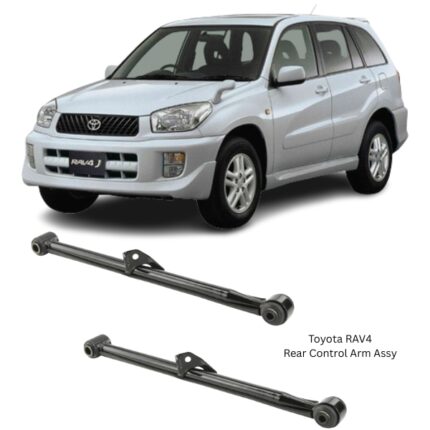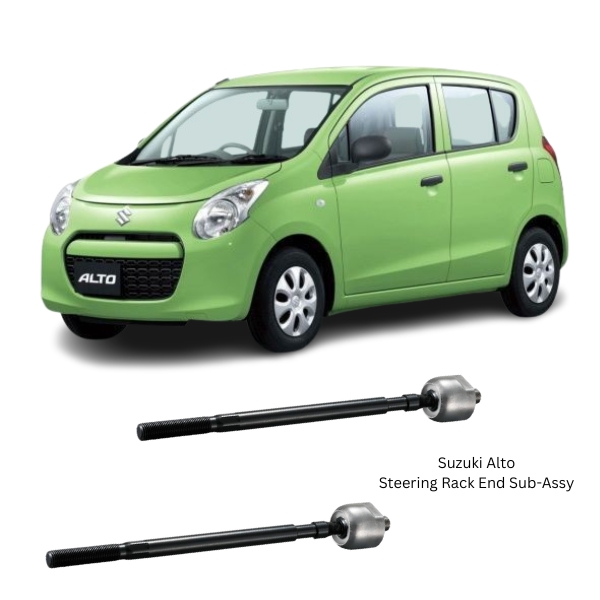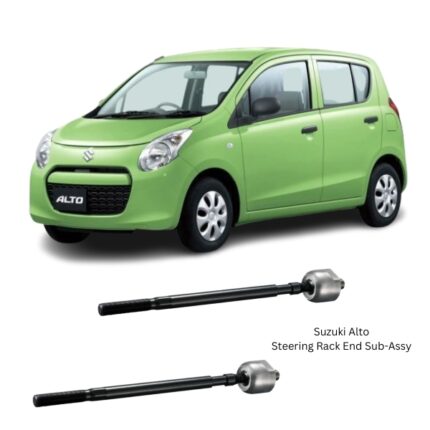-10%
Get Suzuki Alto Steering Rack End Sub-Assy RH/LH 48830-85k00 in Kenya
The Steering Rack End Sub-Assembly, often referred to as the tie rod assembly, is a crucial link in the vehicle’s steering system. It connects the steering rack to the steering knuckle, allowing precise control over the vehicle’s wheel direction. The sub-assembly includes components that accommodate both linear and angular motion, transmitting driver input from the steering wheel all the way to the wheels. These assemblies are typically designated as RH (Right Hand) and LH (Left Hand) to correspond to their respective positions on the vehicle.
Accurate and responsive steering depends heavily on the condition and design of the rack end sub-assemblies. As part of a larger system that directly affects vehicle safety and handling, their role cannot be overstated.
Purpose and Function
The primary function of the steering rack end sub-assembly is to transfer steering input from the rack and pinion gearbox to the steering knuckle, enabling the wheels to turn left or right based on driver input.
Key roles include:
-
Directional Control: Ensures wheels move according to steering wheel rotation.
-
Force Transmission: Converts the rotational motion from the pinion gear into lateral movement.
-
Suspension Flexibility: Maintains wheel positioning while allowing for vertical suspension travel.
-
Alignment Maintenance: Helps sustain correct toe settings for optimal tire wear and handling.
-
Damping Vibrations: Some designs help dampen road-induced vibration and shock.
The rack end sub-assembly functions as a dynamic, high-load joint that must remain precisely engineered to perform without failure under all driving conditions.
Component Composition
A complete Steering Rack End Sub-Assembly (RH/LH) typically includes several critical components:
1. Inner Tie Rod (Rack End)
-
Connects directly to the steering rack.
-
Allows for telescopic movement due to suspension articulation.
-
Constructed from high-strength steel with threaded ends.
2. Ball Socket/Joint
-
Enables multi-directional pivoting necessary for steering and suspension travel.
-
Greased and enclosed within a ball stud housing.
-
Critical for smooth steering response.
3. Protective Boot (Optional)
-
Guards the inner tie rod and ball joint from dirt, water, and debris.
-
Made from rubber or thermoplastic materials.
4. Locking Hardware
-
May include nuts, clamps, or retainers to fix the sub-assembly in place.
-
Prevents loosening under vibration or stress.
Design Characteristics
The steering rack end sub-assembly is designed with a precise balance of strength, flexibility, and longevity:
-
Length: Varies between RH and LH sides to accommodate differences in geometry, especially in off-center steering racks.
-
Thread Pitch and Size: Must match both the steering rack and outer tie rod for secure installation.
-
Ball Joint Angle: Calibrated for the expected range of wheel movement.
-
Tensile Strength: Designed to withstand high shear and pull loads during steering and suspension travel.
Advanced versions may incorporate low-friction materials or sealed joints for enhanced lifespan and reduced maintenance.
Mechanical Operation
When the driver turns the steering wheel:
-
The steering column rotates the pinion gear.
-
The pinion moves the steering rack laterally (left or right).
-
The rack end sub-assembly transfers this lateral movement to the outer tie rod.
-
The outer tie rod then pushes or pulls the steering knuckle, turning the wheel.
Throughout this process, the sub-assembly must:
-
Maintain structural rigidity under load.
-
Allow necessary articulation as the suspension compresses or extends.
-
Ensure tight tolerances to avoid steering play or delay.
Material and Manufacturing
High-performance materials are essential for durability and performance:
-
Steel Alloys: Used for strength and fatigue resistance.
-
Heat Treatment: Applied to critical parts to increase surface hardness and wear resistance.
-
Corrosion Resistance: Surface coatings like black oxide, zinc plating, or phosphate help extend component life.
-
Sealed Ball Joints: Protect internal components from wear caused by contamination.
Tolerances in manufacturing are tightly controlled to prevent:
-
Excessive free play.
-
Uneven wear.
-
Thread deformation.
RH vs LH Considerations
Each side of the vehicle has distinct requirements:
-
Right-Hand (RH) and Left-Hand (LH) sub-assemblies are not interchangeable.
-
They often differ in length, bend geometry, and thread direction.
-
Correct side installation ensures proper steering geometry and alignment.
In some vehicles, only one side may feature an adjustable inner tie rod; the other may be fixed. Always refer to vehicle-specific service documentation when selecting replacements.
Performance Characteristics
A high-quality steering rack end sub-assembly must demonstrate:
a) Precision and Control
-
Eliminates steering lag and dead spots.
-
Enhances direct road feedback.
b) Noise and Vibration Damping
-
Good bushing and joint materials reduce NVH (Noise, Vibration, Harshness) levels.
c) Wear Resistance
-
Withstands constant mechanical load, especially during sharp cornering or rough roads.
d) Sealing and Lubrication
-
Long-lasting internal grease and sealed joints prevent moisture intrusion and rusting.
e) Temperature Tolerance
-
Must perform reliably in both extreme heat and cold, without expansion or contraction affecting fit.
Symptoms of Wear or Failure
Common signs indicating a failing steering rack end sub-assembly include:
-
Loose Steering or Play: Indicating worn inner joints.
-
Clunking or Popping Sounds: Especially during turns.
-
Steering Wheel Vibration: Felt at higher speeds or under load.
-
Vehicle Drifting or Pulling: Due to misalignment or uneven force distribution.
-
Uneven Tire Wear: Resulting from incorrect toe settings caused by worn components.
Maintenance and Replacement
These components are not typically serviceable and should be replaced as a unit when worn or damaged. Proper inspection intervals and prompt replacement help prevent further steering or suspension damage.
Best Practices:
-
Replace both RH and LH assemblies at the same time to maintain balance.
-
Always conduct a wheel alignment after replacement to restore optimal geometry.
-
Use OEM-grade torque specs when tightening.
-
Inspect protective boots regularly for signs of cracking or leaking grease.
Safety and Compliance
As a critical safety component, steering rack end assemblies must conform to strict automotive standards:
-
ISO/TS 16949 or IATF 16949 certifications for manufacturers.
-
Rigorous endurance testing, including:
-
High-cycle stress testing.
-
Salt spray tests for corrosion.
-
Vibration and thermal exposure assessments.
-
-
Fitment and geometry validation against OEM specifications.
Using substandard or mismatched components may result in unpredictable handling or steering system failure.
Follow us on Facebook for more parts.





Reviews
Clear filtersThere are no reviews yet.